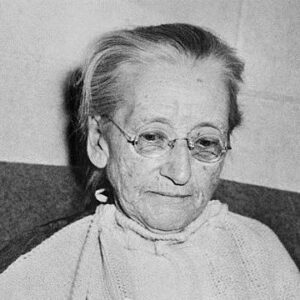Emily Greene Balch was an economist, sociologist, and pacifist from the United States who dedicated her life to humanitarian causes. She was a founding member of the Women’s International League for Peace and Freedom (WILPF) in Switzerland, for which she and John R. Mott shared the Nobel Peace Prize in 1946. She was reared in an intellectually stimulating environment by her well-educated Unitarian parents in Boston. She was a strong student at Bryn Mawr College, where she studied economics and won the college’s first European Fellowship. She then went to Paris to study economics under Émile Levasseur. She went on to have a thriving academic career, which she paired with her long-standing interest in social concerns. She rose through the ranks of the Women’s Trade Union League, focusing on topics such as immigration, juvenile delinquency, and women’s economic roles. She became involved in the peace movement at the start of World War I, collaborating on various initiatives with fellow sociologist and pacifist Jane Addams of Chicago. She became an American leader of the international peace movement and played a key role in the International Congress of Women, continuing her devotion to humanitarian concerns. She never married and devoted the rest of her life to the things she cared about.
Childhood and Adolescence
Emily Greene Balch was born on January 8, 1867, in Boston, Massachusetts, to Francis V. and Ellen (Noyes) Balch, who came from a prominent Unitarian family. Her father was a well-known lawyer who had previously worked as the secretary to US Senator Charles Sumner. She was one of five siblings.
Her parents instilled in their children great moral values and made sure they obtained a good education. Emily attended Boston’s Miss Catherine Ireland’s School before enrolling at Bryn Mawr College in 1886 to study economics. In 1889, she received an A.B. degree.
In 1890–1891, she received a European Fellowship from Bryn Mawr and went to Paris to study economics under Émile Levasseur. She also took short courses at Harvard and the University of Chicago, as well as a full year of economics work in Berlin from 1895 to 1896.
Career of Emily Greene Balch
In 1896, Emily Greene Balch began working at Wellesley College as an assistant professor of economics. She quickly established herself as a bright and committed educator, rising to the level of professor of economics and sociology by 1913.
She had always been engaged in social issues and sat on two local boards (one for children and one for urban planning) as well as two state commissions during this time (one on industrial education, the other on immigration). In addition, she was active in movements for women’s suffrage, racial justice, and immigrant rights. In 1910, she produced ‘Our Slavic Fellow Citizens,’ a landmark sociological study.
She had always been a pacifist at heart, and when World War I broke out in 1914, she became involved in political activism and pacifism. In 1915, she attended the International Congress of Women in The Hague, where she helped to create the Women’s International Committee for Permanent Peace, which later became the Women’s International League for Peace and Freedom.
Independent-minded and outspoken, she wrote ‘Women at The Hague: The International Congress of Women and Its Results’ alongside other like-minded women including Jane Addams and Alice Hamilton (1915).
Wellesley College canceled her contract in 1919 due of her activism and radical behavior. In the same year, she was chosen secretary-treasurer of the newly created Women’s International League for Peace and Freedom at the International Congress of Women’s second conference in Zurich (WILPF).
Her beliefs were shaped by religion and spirituality, and she changed from Unitarianism to Quakerism in 1921. She also became a member of the London Society of Friends in the same year. She was compelled to resign as secretary-treasurer of the WILPF due to health problems during this time. She would, however, be involved with the league in the ensuing years.
In 1926, she was chosen to serve on a WILPF committee that was tasked with investigating the situation in Haiti. She subsequently went to Haiti to assist in the writing and editing of the committee’s report, “Occupied Haiti.” On the basis of the commission’s recommendation, President Herbert Hoover ordered the withdrawal of US soldiers from Haiti.
Throughout the 1930s, Emily Greene Balch worked tirelessly to aid victims of Nazi persecution. She authored ‘Refugees as Assets’ in 1939, advocating the United States to accept refugees fleeing the Nazis. She also pushed for help for Japanese-Americans imprisoned in American detention camps after the 1941 attack on Pearl Harbor. She remained active in humanitarian activities far into her seventies, refusing to be limited by her age or health problems.
Major Projects of Emily Greene Balch
Emily Greene Balch is most known for her work with the Women’s International League for Peace and Freedom (WILPF), a non-profit organization that aimed to bring together women from all over the world who were fighting injustice and exploitation. She was the organization’s secretary-treasurer for a time before being named Honorary International President.
Achievements & Awards
She and John Raleigh Mott shared the Nobel Peace Prize in 1946. Her efforts with the Women’s International League for Peace and Freedom earned her the award (WILPF).
Personal History and Legacy
Emily Greene Balch was a single woman who dedicated her entire life to humanitarian endeavors.
She lived a long life and struggled with health problems in her senior years. She died on January 9, 1961, at the age of 94, at Mr. Vernon Nursing Home in Cambridge, Massachusetts.
Estimated Net Worth
The Estimated net worth of Emily Greene Balch is unknown.


